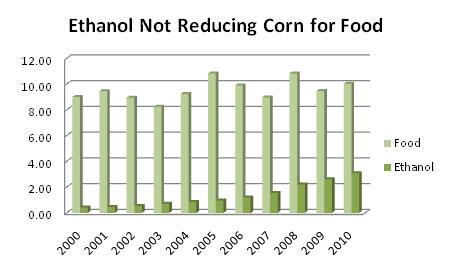Ethanol Is Not Reducing the Amount of Corn for Food
 |
There's actually more corn for food in the U.S. because of increased ethanol production
By Ron Lamberty
Vice President/Market Development
American Coalition for Ethanol
This article comes from the American Coalition for Ethanol blog "www.ethanol.typepad.com" Jan. 26, 2011
While I was amused that The Wall Street Journal would invoke “morality” in one of its editorials, I was stunned by the sheer number of half-truths, miscalculations, and misleading statements that could be wedged into one 600 word anti-ethanol editorial, “Amber Waves of Ethanol.”
The article primarily seeks to blame ethanol for higher food prices, and even the failure of two food companies, yet it includes no discussion about the morality of other Big Food companies who managed to thrive during the time period the others failed, by invoking the mythical “food vs. fuel” bogeyman as an excuse to raise their prices and reap record profits. While the “food vs. fuel” PR campaign was wildly successful, it was not the truth, and it still isn’t.
In fact, the opposite is true. More corn for all other uses is now available in the United States because of growing ethanol production (see chart).
Chart shows the U.S. corn crop in billions of bushels, the portion used to make ethanol, and the portion remaining for food, feed, and export.
Sources: Corn production data: U.S. Department of Agriculture / Ethanol production data: U.S. Department of Energy's Energy Information Service
The WSJ article talks of “reduced corn food supply,” which is at best ignorant of reality. The supply of corn for food in America and around the world is increasing, and in the United States that is due in part to the fact that ethanol has restored market pricing to corn – as opposed to artificially low prices with government payments designed to keep farmers growing cheap corn. Because real grain markets are more attractive, farmers are growing more corn – more food – than ever before. I am continually puzzled by those who think farmers will grow more corn if they are paid less for it. Which economics textbook did I miss that contained that theory?
The article contained many other factual errors, such as ignoring consistently higher corn yields and record-setting corn production, no recognition that ethanol only uses starch and returns all of corn’s protein, fat and fiber to the food supply in the form of the animal feed distillers grain (a 33 percent error), and no recognition of the fact that China – yes, China – is currently accusing U.S. ethanol producers of producing too much of this low-cost feed. I am led to the conclusion that if this is the quality of analysis being used to make decisions on Wall Street, we had better be prepared to bail them out again.
For more information about American Coalition for Ethanol visit www.ethanol.org.



